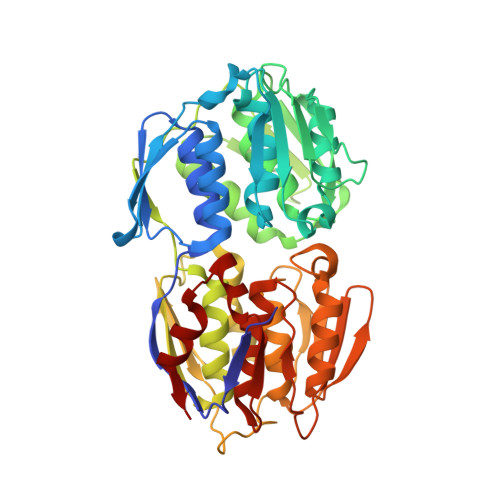Evolving dual-trait EPSP synthase variants using a synthetic yeast selection system.
Reed, K.B., Kim, W., Lu, H., Larue, C.T., Guo, S., Brooks, S.M., Montez, M.R., Wagner, J.W., Zhang, Y.J., Alper, H.S.(2024) Proc Natl Acad Sci U S A 121: e2317027121-e2317027121
- PubMed: 39159366
- DOI: https://doi.org/10.1073/pnas.2317027121
- Primary Citation of Related Structures:
8UMJ, 8UMK, 8UML, 8UMM, 8UMN - PubMed Abstract:
The enzyme 5-enolpyruvylshikimate-3-phosphate synthase (EPSPS) functions in the shikimate pathway which is responsible for the production of aromatic amino acids and precursors of other essential secondary metabolites in all plant species. EPSPS is also the molecular target of the herbicide glyphosate. While some plant EPSPS variants have been characterized with reduced glyphosate sensitivity and have been used in biotechnology, the glyphosate insensitivity typically comes with a cost to catalytic efficiency. Thus, there exists a need to generate additional EPSPS variants that maintain both high catalytic efficiency and high glyphosate tolerance. Here, we create a synthetic yeast system to rapidly study and evolve heterologous EPSP synthases for these dual traits. Using known EPSPS variants, we first validate that our synthetic yeast system is capable of recapitulating growth characteristics observed in plants grown in varying levels of glyphosate. Next, we demonstrate that variants from mutagenesis libraries with distinct phenotypic traits can be isolated depending on the selection criteria applied. By applying strong dual-trait selection pressure, we identify a notable EPSPS mutant after just a single round of evolution that displays robust glyphosate tolerance (K i of nearly 1 mM) and improved enzymatic efficiency over the starting point (~2.5 fold). Finally, we show the crystal structure of corn EPSPS and the top resulting mutants and demonstrate that certain mutants have the potential to outperform previously reported glyphosate-resistant EPSPS mutants, such as T102I and P106S (denoted as TIPS), in whole-plant testing. Altogether, this platform helps explore the trade-off between glyphosate resistance and enzymatic efficiency.
Organizational Affiliation:
McKetta Department of Chemical Engineering, The University of Texas at Austin, Austin, TX 78712.

















